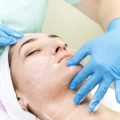Understanding Cheek Fillers: Types and Mechanism
Cheek fillers have become a cornerstone in both preventative and rejuvenative aesthetics, particularly as Americans seek minimally invasive options to manage the visible signs of aging. At their core, cheek fillers are injectable substances designed to restore or enhance facial volume, specifically targeting the midface region where age-related fat loss and bone resorption can lead to sagging and hollowing. The most commonly used materials in the U.S. include hyaluronic acid (HA) fillers such as Juvederm Voluma and Restylane Lyft, as well as calcium hydroxylapatite-based products like Radiesse. Each of these materials interacts differently with facial anatomy; HA attracts water molecules, providing immediate plumpness and a smooth contour, while calcium hydroxylapatite stimulates collagen production for longer-term structural support.
The science behind cheek fillers revolves around their ability to mimic or supplement the body’s natural components. Hyaluronic acid is a naturally occurring molecule in the skin that diminishes with age, so its synthetic form offers both compatibility and reversibility if needed. Calcium hydroxylapatite, on the other hand, is similar to minerals found in human bones, allowing it to integrate seamlessly into existing tissue while triggering neocollagenesis—the formation of new collagen fibers. When skillfully injected, these fillers not only replace lost volume but also lift surrounding tissues by supporting key anatomical structures like the malar fat pad and zygomatic arch. This interplay between filler material and facial anatomy underpins their dual role in prevention—by maintaining youthful contours before significant sagging occurs—and rejuvenation—by correcting established volume loss and restoring youthful facial proportions.
2. Facial Aging: Causes and Visible Effects
Facial aging is a multifactorial process influenced by intrinsic biological changes and extrinsic environmental factors. As we age, the skin, fat, muscle, and bone structures of the face all undergo significant transformations that contribute to the classic signs of aging. Understanding these changes—especially as they pertain to the cheeks—is essential for evaluating both preventative and rejuvenative strategies such as cheek fillers.
Biological Drivers of Facial Aging
The primary biological processes responsible for facial aging include collagen depletion, loss of elastin fibers, redistribution and atrophy of facial fat pads, and gradual bone resorption. These mechanisms collectively lead to decreased skin elasticity, thinning dermal layers, and less structural support beneath the skin. Hormonal shifts and genetic predispositions further modulate the speed and severity of these changes.
Main Contributors to Cheek Aging
| Factor | Impact on Cheeks | Visible Effect |
|---|---|---|
| Collagen Loss | Reduced skin firmness and resilience in midface area | Sagging, fine lines |
| Fat Pad Atrophy & Migration | Loss and downward shift of malar (cheek) fat pads | Flattened cheeks, deeper nasolabial folds |
| Bone Resorption | Decreased support for overlying tissues in cheekbone region | Sunken appearance, hollowing |
| Muscle Changes | Weakened facial muscles reduce lift and tone | Laxity, drooping contours |
The Cheeks: A Key Zone in Facial Aging
The cheeks are central to youthful facial contours. Volume loss here not only flattens the midface but also accelerates sagging along the jawline and deepening of smile lines. Unlike other facial areas, the cheeks are particularly susceptible to combined effects of soft tissue descent and bone remodeling. This makes them a critical target for both prevention—maintaining existing structure—and rejuvenation—restoring lost volume—through interventions like cheek fillers.
![]()
3. Prevention vs. Rejuvenation: Defining the Objectives
When considering cheek fillers as part of an aesthetic treatment plan, it’s critical to distinguish between prevention and rejuvenation—two objectives that cater to different patient needs and expectations. Prevention typically targets individuals in their late twenties to early thirties who seek to address the earliest indicators of volume loss or facial contour changes before they become pronounced. The main goal here is to slow down the visible progression of aging by maintaining optimal midface support and skin elasticity. Preventative strategies often involve subtle enhancements that preserve natural youthful contours, helping patients avoid dramatic transformations later on.
On the other hand, rejuvenation focuses on restoring lost volume and structure in cheeks that already display noticeable signs of aging—such as flattening, sagging, or deepening nasolabial folds. This approach is common among patients in their forties and beyond, whose primary aim is to recapture a more youthful appearance by correcting deficits caused by bone resorption, fat loss, and collagen decline. Here, cheek fillers are used more robustly to lift tissues, recontour the face, and soften age-related shadows or hollows.
For both prevention and rejuvenation, clear communication about goals is essential. Patients seeking prevention are generally motivated by subtlety and long-term maintenance, while those opting for rejuvenation often desire more immediate and visible transformation. Understanding these differences ensures that practitioners can tailor treatment plans with precision—aligning techniques, product selection, and expected outcomes with real-world patient priorities.
4. Clinical Evidence: Efficacy and Longevity of Cheek Fillers
The effectiveness and duration of cheek fillers are critical considerations for both prevention of early signs of aging and the rejuvenation of mature facial features. Recent U.S.-based clinical studies and peer-reviewed research provide valuable insights into how these injectable treatments perform across different patient groups.
Current Research Findings
Multiple clinical trials have evaluated hyaluronic acid (HA) and calcium hydroxylapatite (CaHA) cheek fillers in diverse populations. Results consistently demonstrate significant improvements in midface volume, contour, and patient-reported satisfaction scores. Notably, younger patients seeking preventive treatments report subtle yet natural enhancements, while older cohorts benefit from more pronounced volumization and lifting effects.
Efficacy Metrics in U.S. Studies
| Patient Age Group | Primary Outcome | Satisfaction Rate | Duration of Results |
|---|---|---|---|
| 25-35 (Prevention) | Volume maintenance, early contour enhancement | 92% | 9-12 months |
| 36-55 (Rejuvenation) | Lifting effect, improved definition | 88% | 12-18 months |
| 56+ | Restoration of lost volume, wrinkle reduction | 85% | 9-15 months |
Factors Influencing Longevity and Effectiveness
The duration of cheek filler results varies based on several technical factors, including product type (HA vs. CaHA), injection depth, cross-linking technology, individual metabolism, and lifestyle factors such as sun exposure or smoking. Preventive use typically requires less product per session and may extend intervals between touch-ups, whereas rejuvenation protocols often involve higher volumes and strategically layered injections to maximize lift and support.
Summary of Clinical Consensus in the U.S.
A growing body of American clinical data supports that cheek fillers offer both preventative and restorative benefits, with high safety profiles when administered by experienced injectors. The average duration ranges from 9 to 18 months depending on age, indication, and technique. For patients prioritizing either prevention or rejuvenation, a personalized approach based on anatomical assessment ensures optimal outcomes tailored to their stage in the aging process.
5. Cultural Perspectives and Patient Expectations in America
American beauty standards have a profound impact on the popularity and perception of cheek fillers, particularly regarding aging. In the United States, there is a strong cultural emphasis on youthfulness, defined facial contours, and an overall vibrant appearance. These ideals drive both the preventive and rejuvenative use of cheek fillers, as individuals seek to maintain or restore facial harmony that aligns with societal expectations.
Common aesthetic goals among American patients include high, well-defined cheekbones and a smooth transition from the midface to the lower face. These features are often associated with health, vitality, and attractiveness in mainstream media and celebrity culture. As a result, many people turn to cheek fillers not only to reverse visible signs of aging but also as a proactive measure to delay volume loss and sagging before they become pronounced.
Societal attitudes toward cosmetic procedures in America are generally open-minded, yet nuanced. There is increasing normalization of minimally invasive enhancements like fillers, especially among younger adults who view them as routine self-care rather than drastic interventions. However, patient expectations can vary widely based on age group, cultural background, and personal values. Some prioritize subtlety and natural results, while others desire more dramatic transformations that reflect current trends seen on social media platforms.
This dynamic environment means that practitioners must be adept at understanding individual motivations and tailoring treatment plans accordingly. Open communication about realistic outcomes, potential risks, and long-term maintenance is critical for aligning clinical strategies with patient aspirations shaped by American beauty culture.
6. Risks, Limitations, and Responsible Practices
While cheek fillers offer significant benefits for both the prevention and rejuvenation of facial aging, it’s crucial to recognize the risks, limitations, and the importance of responsible practices.
Potential Complications
Cheek fillers are generally safe when performed by qualified medical professionals, but they are not without risk. Common side effects include swelling, bruising, redness, and tenderness at the injection site. More serious complications—though rare—can include infection, vascular occlusion (blockage of a blood vessel), and asymmetry. Allergic reactions to filler materials are also possible, making a thorough medical assessment essential before any procedure.
Overuse Trends and Aesthetic Concerns
With the rise of social media filters and beauty standards in American culture, overuse of fillers has become increasingly common. This can result in an unnatural or “overfilled” appearance, sometimes referred to as “pillow face.” Such outcomes not only compromise aesthetics but may also cause long-term tissue distortion. Responsible providers emphasize moderation and prioritize maintaining the patient’s unique facial features rather than chasing unrealistic ideals.
Best Practices for Natural Results
Achieving natural-looking results while minimizing risks requires a combination of advanced technique, appropriate product selection, and individualized treatment planning. Board-certified dermatologists or plastic surgeons should conduct a comprehensive facial assessment, discuss realistic goals with patients, and tailor the volume and placement of fillers to each person’s anatomy. Gradual enhancement over multiple sessions often yields safer and more harmonious results compared to aggressive single treatments.
Patient Education and Informed Consent
An informed patient is key to successful outcomes. Providers should educate patients about potential side effects, longevity of results, maintenance needs, and what to expect during recovery. Encouraging open dialogue ensures that expectations align with achievable outcomes and supports long-term satisfaction.
In summary, while cheek fillers are a valuable tool in both preventing and reversing signs of aging, understanding their risks and practicing restraint are essential for achieving authentic results that enhance rather than mask one’s natural beauty.

